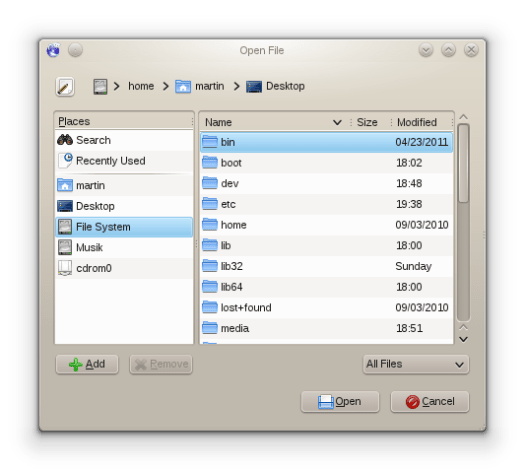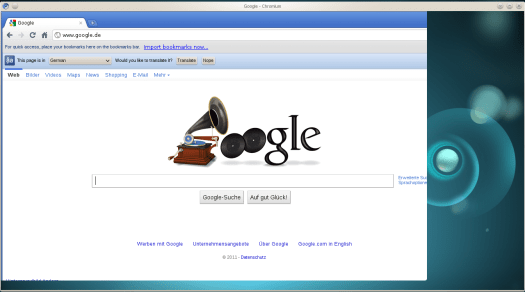Short update from the Wayland efforts:

=-=-=-=-=
Powered by Blogilo

From the land of wobbly windows
Short update from the Wayland efforts:

=-=-=-=-=
Powered by Blogilo
WebGL erlaubt es OpenGL in Webseiten einzubetten, also 3D Grafiken auf der lokalen Hardware direkt zu rendern. WebGL baut auf der API von OpenGL ES 2.0 auf, welches selbst eine Untermenge (und Teilweise Übermenge) von OpenGL 2 ist. Eine Webseite, die WebGL einbindet, funktioniert somit prinzipiell auf aller Hardware die entweder OpenGL 2 oder OpenGL ES 2.0 unterstützt. Das ist so ziemlich jedes moderne Smartphone und auch jede Grafikkarte der letzten Jahre.
=-=-=-=-=
Powered by Blogilo
Es sollte ja kein Geheimnis mehr sein, dass der X Server mitlerweile angezählt ist und mit Wayland der potentielle Nachfolger bereits in den Startlöchern steht. Auch wenn es noch lange dauern wird bis wir X endlich in den Ruhestand schicken können, ist für mich bereits der Zeitpunkt gekommen, mich etwas intensiver mit der neuen Technologie zu beschäftigen. Für KWin ist es wichtig früh Wayland Anwendungen zu integrieren, da man unter KDE Plasma Wayland nicht benutzen kann, wenn KWin Wayland nicht unterstützt.

=-=-=-=-=
Powered by Blogilo
This weekend a group of KDE hackers met in a small mountain village, Randa, in Switzerland to discuss the future of the KDE Frameworks. I was not present, but started on Saturday an endevour for the future of the KDE Plasma Workspaces. Yesterday evening I arrived in the new world:
=-=-=-=-=
Powered by Blogilo
This is a guest post by my Google Summer of Code student Arthur Arlt.
=-=-=-=-=
Powered by Blogilo
In the KDE Plasma Workspaces 4.7 we introduce new Compositing backends/modes in our Compositor. Lately I noticed that there is some misunderstanding on what are the differences between the modes, why we wrote new code and what is the best mode for whom (at least one distribution did it wrong in their first packaging approach). With this blog post I hope to shed light on the various modes.
OpenGL vendor string: Advanced Micro Devices, Inc. OpenGL renderer string: Mesa DRI R600 (RV710 954F) 20090101 TCL DRI2 OpenGL version string: 2.1 Mesa 7.10.2 OpenGL shading language version string: 1.20 Driver: R600C GPU class: R700 OpenGL version: 2.1 GLSL version: 1.20 Mesa version: 7.10.2 X server version: 1.10.1 Linux kernel version: 2.6.38 Direct rendering: yes Requires strict binding: no GLSL shaders: yes Texture NPOT support: yes
And for OpenGL ES:
OpenGL vendor string: X.Org OpenGL renderer string: Gallium 0.4 on AMD RV710 OpenGL version string: OpenGL ES 2.0 Mesa 7.10.2 OpenGL shading language version string: OpenGL ES GLSL ES 1.0.16 Driver: R600G GPU class: R700 OpenGL version: 2.0 GLSL version: 1.0.16 Mesa version: 7.10.2 X server version: 1.10.1 Linux kernel version: 2.6.38 Direct rendering: yes Requires strict binding: yes GLSL shaders: yes Texture NPOT support: yesTo distinguish OpenGL 1 from OpenGL 2 backend there is one debug message related to "KWin::ShaderManager::initShaders". There should be three messages for valid - then OpenGL 2 is used or at least one message on failure, then OpenGL 1 is used. Recognizing XRender is even more difficult. In case that we face issues for debugging we will add more precise debug messages. Personally I test which backend is used by using functionality tests: the Cube Effect requires at least OpenGL and the Sphere and Cylinder effects require at least OpenGL 2.
Why a new Backend?
There are several reasons why I started to work on the OpenGL 2/OpenGL ES 2.0 backend. First of all we wanted to have support for everything which is nowadays known as Plasma Active, but also Wayland is very important on the longer term. Currently Wayland requires an EGL backend, so having support for EGL is a prerequisite. Last but not least to give our users the best possible performance and user experience. The programmable pipeline is a way nicer API to write GL code and especially the ES code can benefit users as it throws out all the legacy code and state tracking, which is rather complex in OpenGL and should ensure better drivers.=-=-=-=-=
Powered by Blogilo
With the first Beta for KDE Plasma Workspaces 4.7 out of the door it is time to look back what we achieved in the last half year for the KDE Plasma Compositor and Window Manager. Personally I think this will become a very great release with hughe improvements for our users. The best about it is, that users should not even notice that anything changed at all. Almost everything we did is under the hood improving performance, stability and rendering.
=-=-=-=-=
Powered by Blogilo
This week there was an interesting, but too heated discussion on kde-devel about the feature or bug of dragging windows from any empty space. I don’t want to comment on the topic as I participated in the discussion and by that are biased and this is post is not about the feature but more about what we can derive from such discussions.


Rationale: This hint is intended to replace the MOTIF hints. One of the objections to the MOTIF hints is that they are a purely visual description of the window decoration. By describing the function of the window, the Window Manager can apply consistent decoration and behavior to windows of the same type. Possible examples of behavior include keeping dock/panels on top or allowing pinnable menus / toolbars to only be hidden when another window has focus (NextStep style).

=-=-=-=-=
Powered by Blogilo
Wer die OpenSource Medien gestern oder heute verfolgt hat, dürfte ja schon mitbekommen haben, dass Nokia Qt 5 für nächstes Jahr angekündigt hat. Das hat natürlich auch Auswirkungen auf KDE. Um die Neuerungen von Qt 5 verwenden zu können, müssen wir gegen die neue Version linken, wodurch unsere KDE Platform eine binär inkompatible Änderung erhält. Die Folge davon ist recht logisch: KDE Plattform 5.
=-=-=-=-=
Powered by Blogilo
KWin has been known as a rock-solid window manager in the KDE 3.5 times. I was wondering how the situation is nowadays with focus no longer on window managing but on compositing. Currently we are experiencing a major problem in combination of Intel/Mesa drivers with either fullscreen flash videos or OpenGL screensavers. Since the release of Kubuntu Natty we receive two to three new duplicates each day. In case you are experiencing this issue: do not report! Neither to us, nor to Mesa nor to (K)Ubuntu. It is a known issue and Upstream is working on a fix! As a workaround, do not use Flash to watch Youtube videos and do not use OpenGL screensavers. The issue is the most often reported bug against KWin of all time, now.
=-=-=-=-=
Powered by Blogilo